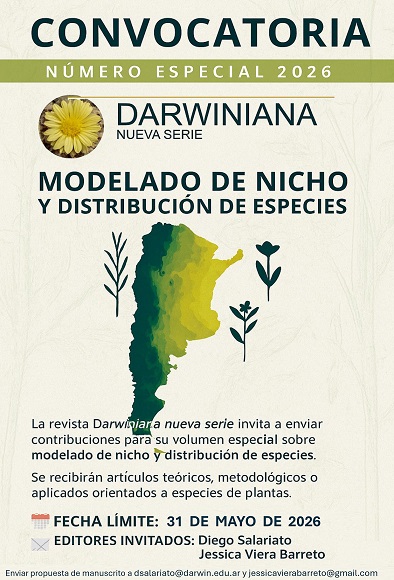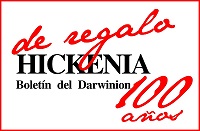Análisis cladístico de la familia Cryphaeaceae (Bryophyta) con énfasis en Cryphaea: un estudio basado en un conjunto integral de datos morfológicos
DOI:
https://doi.org/10.14522/darwiniana.2017.51.728Palabras clave:
Parsimonia, pesos implicados, musgos pleurocárpicos, sistemática, taxonomíaResumen
El primer análisis filogenético de Cryphaeaceae (Bryophyta), una familia de musgos pleurocárpicos, se lleva a cabo sobre la base de caracteres morfológicos. El conjunto de datos consta de 73 caracteres: 10 continuos y 63 discretos. El muestreo de taxa incluye 9 géneros y 46 especies de Cryphaeaceae, 32 especies pertenecientes a Cryphaea. El grupo externo, incluye 23 especies de 21 géneros y 13 familias de musgos pleurocarpous. Los análisis filogenéticos se realizaron utilizando parsimonia bajo pesos implicados. Los resultados no apoyan la monofilia de Cryphaeaceae ya que excluye a Dendroalsia abietina de la familia. El clado compuesto por los géneros restantes (clado A) fue diagnosticado por una seta corta (0,26-0,30 mm), costa presente en todas las hojas periqueciales internas, opérculo cónico y hojas adpresas al estado seco. Los análisis además recuperaron Cryphaea como parafilético y Dendrocryphaea como polifilético. Cryphaea incluye Schoenobryum concavifolium, Cyptodontopsis leveillei, y Dendrocryphaea lamyana que se separaron de las otras especies de Dendrocryphaea. El mapeo de caracteres reveló que, como consecuencia de la ubicación inesperada de especies cruciales, la diagnosis debería ser considerablemente modificada.Citas
Bridel, S. E. 1819. Muscologiae recentiorum supplementum pars IV seu Mantissa Generum Specierumque Muscorum Frondosorum Universa. Lipsiae: Apud. J. A. Barthium.
Brotherus, V. F. 1903. Bryales II: Spezieller Teil., in Engler, A. & Prantl, K. (eds.), Die Natürlichen Pflanzenfamilien nebst ihren Gattungen und wichtigeren Arten, insbesondere den Nutzpflanzen, unter Mitwirkung zahlreicher hervorragender Fachgelehrten begründet I, Abt. III, Halfte I (277-1246). Leipzig: W. Englemann publisher.
Brotherus, V. F. 1905. Cryphaeaceae, Leucodontaceae, in Engler, A. & Prantl, K. (eds.), Die Natürlichen Pflanzenfamilien nebst ihren Gattungen und wichtigeren Arten, insbesondere den Nutzpflanzen, unter Mitwirkung zahlreicher hervorragender Fachgelehrten begründet I, Abt. III Halfte II (736-762). Leipzig: W. Englemann publisher.
Brotherus, V. F. 1924. Musci (Laubmoose), in Engler, A. & Prantl, K. (eds.), Die Natürlichen Pflanzenfamilien nebst ihren Gattungen und wichtigeren Arten, insbesondere den Nutzpflanzen, unter Mitwirkung zahlreicher hervorragender Fachgelehrten begründet 2, Band 11 (1-542). Berlin: Duncker & Humblot publisher.
Buck, W. R. 1980. Animadversions on Pterigynandrum with special commentary on Forsstroemia and Leptopterigynandrum. The Bryologist 83(4): 451-465. DOI: 10.2307/3242298
Buck, W. R. 1988. Another view of familial delimitation in the Hookeriales. Journal of Hattori Botanical Laboratory 64: 29-36.
Buck, W. R. 1998. Pleurocarpous mosses of the West Indies. Memoirs of the New York Botanical Garden 82: 1-400.
Buck, W. R.; B. Goffinet & J. Shaw. 2000. Testing morphological concepts of orders of pleurocarpous mosses (Bryophyta) using phylogenetic reconstructions based on trnL-trnF and rps4 sequences. Molecular Phylogenetics and Evolution 16(2): 180-198. DOI: 10.1006/mpev.2000.0805
Capesius, I. & M. Stech. 1997. Molecular relationships within mosses based in 18S rRNA gene sequences. Nova Hedwigia 64: 525-533.
Cox, C. J. & T. J. Hedderson. 1999. Phylogenetic relationships among the ciliate arthrodontous mosses: Evidence from chloroplast and nuclear DNA sequences. Plant Systematics and Evolution 215(1): 119-139. DOI: 10.1007/BF00984651
Cox, C. J.; B. Goffinet; N. J. Wickett, S. B. Boles & A. J. Shaw. 2010. Moss diversity: a molecular phylogenetic analysis of genera. Phytotaxa 9: 175-195. DOI: 10.11646/phytotaxa.9.1.10
De Luna, E.; A. E. Newton, A. Withey, D. González & B. D. Mishler. 1999. Ordinal phylogeny within the Hypnobryalean Pleurocarpous Mosses inferred from cladistic analyses of three chloroplast DNA sequence data sets: trnL-F, rps4 and rbcL. The Bryologist 103(2): 242-256.
Dusén, P. 1905. Musci nonnulli novi e Fuegia et Patagonia reportati. Botaniska Notiser 11: 299-310.
Farris, J. S.; V. A. Albert, M. Källersjö, D. Lipscomb & A. G. Kluge. 1996. Parsimony jackknifing outperforms neighbor joining. Cladistics 12: 99-124. DOI: 10.1111/j.1096-0031.1996.tb00196.x
Felsenstein, J. 1985. Confidence limits on phylogenies: an approach using the bootstrap. Evolution 39: 783-791. DOI: 10.2307/2408678
Fleischer, M. 1906. Die Musci der Flora von Buitenzorg : zugleich Laubmoosflora von Java. Flore de Buitenzorg 5(3): 645-1100. DOI: 10.5962/bhl.title.44870
Fleischer, M. 1914. Kritische Revision von Carl Müllerschen Laubmoosgattungen. Hedwigia 55: 280-285.
Flores, J. R. & G. M. Suárez. 2014. Redescription of the genus Cryphidium (Cryphaeaceae, Bryophyta), with notes on its taxonomy. Boletín de la Sociedad Argentina de Botánica 49(2): 195-199.
Goffinet, B.; W. R. Buck & A. J. Shaw. 2009. Morphology, anatomy and classification of Bryophyta, in Goffinet, B. & A.J. Shaw (eds.), Bryophyte biology. 2nd edition, pp.55-138. Cambridge: Cambridge University Press.
Goloboff, P. A. 1993. Estimating character weights during tree search. Cladistics 9(1): 83-91. DOI: 10.1111/j.1096-0031.1993.tb00209.x
Goloboff, P. A. 1999. Analyzing large data sets in reasonable times: solutions for composite optima. Cladistics 15(4): 415-428. DOI: 10.1111/j.1096-0031.1999.tb00278.x
Goloboff, P. A.; J. S. Farris & K. C. Nixon. 2008a. TNT, a free program for phylogenetic analysis. Cladistics 24(5): 774-786. DOI: 10.1111/j.1096-0031.2008.00217.x
Goloboff, P. A.; J. M. Carpenter, J. S., Arias & D. R. M. Esquivel. 2008b. Weighting against homoplasy improves phylogenetic analysis of morphological data sets. Cladistics 24(5): 758-773. DOI: 10.1111/j.1096-0031.2008.00209.x
Goloboff, P. A.; C. I. Mattoni & A. S. Quinteros. 2006. Continuous characters analyzed as such. Cladistics 22(6): 589-601. DOI: 10.1111/j.1096-0031.2006.00122.x
Gradstein, S. R.; S. P. Churchill & A. N. Salazar. 2001. Guide to the bryophytes of tropical America. Memoirs of the New York Botanical Garden 86: 1-577.
Hedenäs, L. 1994. The basal pleurocarpous diplolepidous mosses: A cladistic approach. The Bryologist 97(3): 225-243. DOI: 10.2307/3243454
Hedenäs, L. 1995. Higher taxonomic level relationships among diplolepidous pleurocarpous mosses—A cladistic overview. Journal of Bryology 18(4): 723-781. DOI: 10.1179/jbr.1995.18.4.723
Hedenäs, L. 1996a. A cladistic evaluation of relationships between the Hookeriales, the Sematophyllaceae and some other taxa. Lindbergia 21(2): 49-82.
Hedenäs, L. 1996b. A cladistic overview of the “Hookeriales” Lindbergia, 21(3): 107-143.
Jaeger, A. 1876. Adumbratio flore muscorum totius orbis terrarum. Part 6. Bericht über die Thätigkeit der St. Gallischen Naturwissenschaftlichen Gesellschaft, 1874-1875: 85-188.
Kühnemann O, Gonçalves Carralves MF. (1976) Sobre Cryphaeophilum molle (Dus.) Fleisch. Meteoriaceae-Briofitas. Boletín de la Sociedad Argentina de Botánica 17(3-4): 247–251. Boletín de la Sociedad Argentina de Botánica 17(3-4): 247–251.
La Farge-England, C. 1996. Growth form, branching pattern, and perichaetial position in mosses: Cladocarpy and pleurocarpy redefined. The Bryologist 99(2): 170-186. DOI: 10.2307/3244546
Lipscomb, D. L. 1992. Parsimony, homology and the analysis of multistate characters. Cladistics 8(1): 45-65. DOI: 10.1111/j.1096-0031.1992.tb00050.x
Maeda, S.; K. Ksuge, D. González, E. De Luna & H. Akiyama. 2000. Molecular phylogeny of the suborder Leucodontineae (Musci; Leucodontales) inferred from rbcL sequence data. Journal of Plant Research 113(1): 29-38. DOI: 10.1007/PL00013900
Manuel, M. G. 1973. Studies in Cryphaeaceae I. A revision of the genus Cryphaea in North America north of Mexico. The Bryologist 76(1): 144-162. DOI: 10.2307/3241235
Manuel, M. G. 1974. A revised classification of the Leucodontaceae and a revision of the subfamily Alsioideae. The Bryologist 77(4): 531-550. DOI: 10.2307/3241800
Manuel, M. G. 1981. Studies in Cryphaeaceae V. A revision of the family in Mexico, Central America and the Caribbean. Journal of Hattori Botanical Laboratory 49: 115-140.
Manuel, M. G. 1982. A brief review of the systematics of the Leucodontaceae and the Cryphaeaceae. Beiheft Zur Nova Hedwigia 71: 281-289.
Mirande, J. M. 2009. Weighted parsimony phylogeny of the family Characidae (Teleostei: Characiformes). Cladistics 25(6): 1-40. DOI: 10.1111/j.1096-0031.2009.00262.x
Mitten, W. 1869. Musci austro-americani. Enumeratio muscorum omnium austroamericanorum auctori hucusque cognitorum. The Journal of the Linnean Society. Botany 12: 1-659.
Quandt, D.; S. Huttunen, H. Streimann, W. Frey & J. P. Frahm. 2004. Molecular phylogenetics of the Meteoriaceae s. str. focusing on the genera Meteorium and Papillaria. Molecular Phylogenetics and Evolution 32(2): 435-461. DOI: 10.1016/j.ympev.2003.12.012
Rao, P. & J. Enroth. 1999. Taxonomic studies on Cryphaea (Cryphaeaceae, Bryopsida) 1. The Chinese species and notes on Cyptodontopsis. Bryobrothera 5: 177-188.
Rao, P. 2000. Taxonomic studies on Cryphaea (Cryphaeaceae, Bryopsida) 2. Revision of Asian species. Annales Botanici Fennici 37(1): 45-56.
Rao, P. 2001. A synopsis of the genus Cryphaea (Cryphaeaceae, Bryopsida). Bryobrothera 7: 1–35.
Robinson, H. 1972. The status of the genus Cryphidium. Phytologia 23: 149-150. DOI: 10.5962/bhl.part.19871
Sankoff, D. & P. Rosseau. 1975. Locating the vertices of a Steiner tree in an arbitrary metric space. Mathematical Programming 9(1): 240-246. DOI: 10.1007/BF01681346
Schimper, W.P. 1856. Corollarium Bryologiae Europaeae: conspectum diagnosticum familiarum, generum et specierum, adnotationes novas atque emendationes complectens. Stuttgart: E. Schweizerbart.
Sharp, A. J.; H. Crum & P. M. Eckel. 1994. The moss flora of Mexico. Memoirs of the New York Botanical Garden 69: 1-1113
Suárez, G. M. & M. M. Schiavone. 2004. Comentarios sobre la Posición de Cryphaea furcinervis Müll. Hall y Cryphaea lorentziana Müll. Hall. dentro de Cryphaea (Cryphaeaceae, Musci). V Reunión Argentina de Cladística y Biogeografía. Salta, Argentina.
Suárez, G. M. & Schiavone, M. M. 2010. La familia Cryphaeaceae (Bryophyta) en los bosques del noroeste de Argentina. Boletín de la Sociedad Argentina de Botánica 45: 29-45.
Weber, F. 1813. Tabula exhibens calyptratarum operculatarum sive muscorum frondosorum genera. Kilice: C. F. Mohr.
Descargas
Publicado
Cómo citar
Número
Sección
Licencia

A partir de 2012, esta obra está licenciada bajo una Licencia Creative Commons Atribución-NoComercial 2.5 Argentina .
Cualquier obra derivada deberá estar previamente autorizada con nota escrita de los editores.








